A lot of this information here comes from the book “The Perfect Corner” by https://www.paradigmshiftracing.com/.
Imagine a tight 180 degree turn followed by a long straightaway. We have been taught that in such a scenario, a late apex is critical, because even though it results in a lower minimum speed in the corner (compared to taking a larger constant radius geometric arc), it allows us to get on the gas sooner, giving us a higher exit speed, and we carry that higher speed advantage all the way down the straightaway.
Countless books, websites, videos, courses, and instructors talk about this, but unfortunately, not everything we are told about late apexing and early throttle is true. Certainly, getting on the gas early is absolutely vital for a good lap time, but we don’t have a good system for determining how early we should be getting on the gas. Unfortunately, most of us (1) misunderstand the effect/benefit of getting on the gas early, (2) are taught to think incorrectly about what “getting on the gas early” even means, and (3) don’t have a clear way to know for sure whether our chosen apex was correct or not.
Finding the right apex
Let’s work through an example with the aforementioned 180 degree corner.
If we drove the largest perfectly circular arc possible through this corner, we would apex at the geometric center. By virtue of being the largest circle that fits, this line would give us the highest minimum speed through the corner. However, it also means we would be unable to accelerate at all until the very end of the corner. The laws of physics simply wouldn’t allow it. If we are driving at the absolute limit on what is already the largest possible arc, then if we start accelerating at any point before the end of the corner, our arc will get bigger, and we will run off the track.
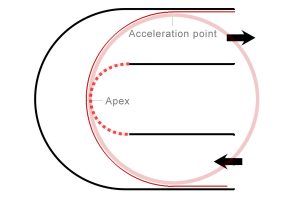
Thus, if we want to accelerate out of the corner earlier, we need to drive along a smaller circle (i.e. a tighter line) earlier in the corner, so that we have room to open up our radius for our acceleration arc. Doing so has 3 effects: (1) Our minimum speed becomes slower because of being on a smaller circle, (2) our apex moves further/later into the corner, and (3) our acceleration point moves earlier in the corner.
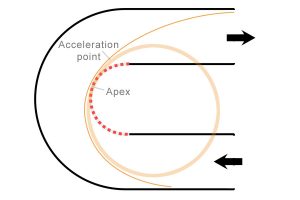
So far so good. We may have a lower speed in the earlier part of the corner, but can now accelerate out much sooner! But how do we know if we have optimized our exit? How late our apex should be? How early should we be accelerating out of the corner?
There is a common saying in the racing world that you shouldn’t get on the throttle until you are sure you won’t have to lift. While that is true, the real answer is even simpler than that. The ideal acceleration point, every single time, is at the apex. On every standalone corner (i.e. not linked corners) on every track in the entire world, the correct acceleration point is always at the apex. Not before, not after. At the apex. Furthermore, we can judge the precision of our apex by whether we were able to accelerate out of the corner effectively from that point. If our ideal acceleration arc from the apex does not allow us to just barely stay on track at corner exit, it simply means we made a mistake and need to adjust our apex.
In our example above, apexing a little after the geometric center allowed us to accelerate out of the corner sooner than we were previously able to, but it was still after our new apex. This tells us that we need to move our apex even later, to move our acceleration point earlier to match.
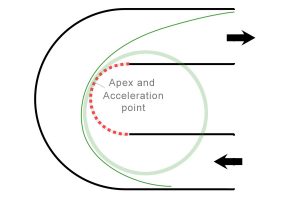
KEY LEARNING: Another way to look at the apex is that it is the point on the inside of the corner that limits our ability to go faster through that corner. While the apex is usually a point on the inside curbing of a track, or a cone on an autocross course, it can be anything! It could be the edge of a puddle when racing in the rain. It could be a severe bump. No matter what, our deceleration and acceleration revolves around that one point.
Of course, all of this is affected by the amount of power and grip we have. A car that has the capability to accelerate out of a corner with 0.9 g’s needs more room on corner exit than a car that can only accelerate out at 0.3 g’s. Therefore a more powerful car needs a later apex. Conversely, a car that can corner at 1.5 g’s will utilize an earlier apex than a car that can only corner at 1.0 g’s because of the more biased grip to power ratio. This is why different cars will have different ideal apexes, and thus different ideal lines.
TAKE ACTION: Think through how the location of the apex is affected by worn out tires, or driving in the rain. Think through how the location of the apex is affected by having more lateral grip than longitudinal grip, and vice versa.
Why not get on the gas even earlier?
We saw that by moving our apex later, we were able to accelerate out of the corner sooner. So why not make the apex even later so we can start accelerating before the apex? There are several websites, images, books, and even racing schools that advocate this idea.
Certainly, we could utilize such a late apex that our speed at the apex and onto the straightaway is even higher. But it will result in a greater elapsed time for the corner as well as for the entire lap. The reason for this is actually very simple. Recall, our goal is to get on the throttle as soon as possible, but the key is that it should be based on time, not position. From the point that we hit the brakes to enter the corner, we want to minimize the time before we are able to accelerate. It turns out that the fastest way to accomplish this puts our acceleration point at the apex.
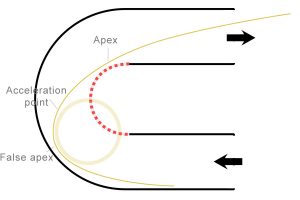
With driving a super-late apex line in an attempt to accelerate before the apex, we are mistakenly thinking in terms of position instead of time. Because the super-late apex line will, by definition go “deeper” into the corner, as well as have a tighter radius, it is going to take longer to get to the minimum speed for the corner, not to mention also require driving a longer distance to get around the “false apex” we have created for ourselves. So while we are able to get on the gas before the real apex in terms of position, we will be getting on the gas later in terms of time, while also doing so from a lower speed.
KEY LEARNING: It is critical to make the comparison based on time, and not on position. Even though we may be at a higher speed when comparing at a particular position on track, we will be at a lower speed when comparing at any particular time.
What if we have an infinitely long straightaway after the corner?
We have been told a thousand times that if we carry 1 mph more onto the straightaway, we will carry that advantage over the entire length of the straightaway. So if we have a really long straightaway after the corner, eventually the super-late apex line will catch up and pass the “correct” line, right?
Sadly, no, it will never catch up. Again, we must remember to make comparisons based on time and not on position on the track. Let’s contrive an example to illustrate this:
Imagine one car on the correct apex line, and another identical car on the super-late apex line. Let’s say they both come hurtling towards the 180 degree turn at 150 mph. The 2 cars will likely have to brake at the same point because even though the car on the correct apex line will be turning in sooner, the super late apex car has to slow down more for the tighter turn it is making. Still, let’s give the super-late car the benefit of the doubt and say that maybe it was able to brake just a hair later. So it will gain a tiny bit of time during the initial braking phase. However, once the car on the correct line turns in, it is driving a significantly shorter distance, and doing so at a higher speed, while the super-late car is still slowing down more to make the tighter turn deeper into the corner.
Let’s assume that the car on the correct line had a minimum speed of 50 mph, while the super-late car had to slow down to 40 mph. It would be complicated to express the mathematics here, but hopefully it is intuitive that it will take the super-late apex car longer to slow down from 150 mph to 40 mph, get turned, and accelerate up to 50 mph, all while driving a longer distance, than it will for the car on the correct apex line to slow down from 150 mph to 50 mph, get turned, and begin accelerating again. Even if the car on the super-late line is able to begin accelerating from 40 mph before the car on correct line begins accelerating, the mathematics of distance, speed, and acceleration dictate that it will not be able to reach 50 mph before the car on the correct line begins to accelerate from it’s apex at 50 mph. Thus, the super-late apex car will always be slower and remain behind the car on the correct line.
Don’t just take my word for it. Review in-car videos of Formula 1 drivers going around turn 11 before the long straightaway at the Circuit of the Americas. Even with such a long straightaway, Lewis Hamilton and Sebastian Vettel set their apex such that they begin to accelerate exactly at the apex.
Hamilton setting the lap record in 2017
Vettel setting the lap record in 2015

Hence, the fallacy of getting on the gas early
We now have a system to find exactly the right apex for our car in any corner, and we know that we must get on the gas exactly at the apex. Apexing earlier will delay our acceleration, and apexing later will put us on a longer path at a lower speed, with no “payoff” no matter how long the subsequent straightaway. In other words, our objective is not to accelerate early or late; it is to accelerate at the apex. If we are able to accelerate earlier (i.e. before the apex), then we were either under the limit during corner entry, or we are on a too-late apex line. If we were unable to accelerate at the apex, then we simply apexed too soon.
For any particular combination of car, corner, and conditions, it is important to understand that there is no such thing as a “late apex” or “early apex”; there is only a correct apex.
While there are certain situations (final corner before beginning a qualifying lap, or when trying to make a pass, etc) where an apex that is earlier/later than optimal can be useful, from the perspective of getting the fastest possible lap time, there is only one correct apex in each corner for a given car.
TAKE ACTION: Think through how this applies to other types of corners. For example, long “carousel” type corners, 90 degree bends, or increasing radius corners. Think through how this is affected by linked corners.

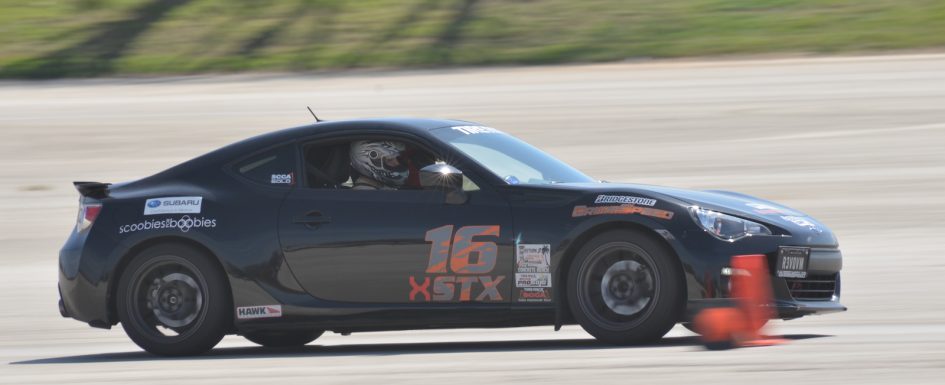
Very good information. I had my doubts when I came accros similar information while reading the book “The Perfect Corner”, as it went against what almost everyone else on the paddock was doing/saying. I then started looking at the really fast drivers, not the ones on fast cars, but the ones on shitty cars but that still go super fast, and noticed a trend, they all seemed to use an apex I would consider too early back then. I started trying to use this along with a method I’d call maximizing the traction circle, which basically was, if I was turning but still had grip left but couldnt take advantage of turning tighter, I would get on the gas, even if it was before the apex, and next time around the same corner, I’d carry more speed. I started doing geometrical apexes first, and realized that even when I missed some of them, or some of them were leading into big straights, my times were still better than when trying to get late apexes everywhere and worrying about exit speed too much.
It took some of those fast drivers (that are usually not the type who talks a lot, or anything at all), to say something simple and without much meaning to many for everything to click in. “Speed is just distance over time”. Thats it, a lot of people, specially the super late apex crowd, focus only on speed, but increase driving distance over the course of a lap to do so, usually resulting in lost time overall.
I wish people would start thinking of time straight away, since after all, we are chasing lap times, not speed trap records.
Victor, there is also VERY good information in the book “Driving on the Edge” by Michael Krumm.
Thanks for the suggestion, I’ll read that one this summer then! I like to do some reading in between track days. Theory to complement practice.
The notion that an autocross apex is always at a cone and always the point of acceleration is a little jarring. It also makes sense and fits my experience. It’s very clarifying and makes creating a drive plan so much simpler.
Thanks Vivek
Jay: I don’t think he’s saying that the apex is at a cone in autocross. Even if the designer meant the cone to be the apex, it still could only be approximately correct for a car of a certain grip and power. And the cone might be nowhere near any car’s proper apex.
From what I can tell from the videos, the F1 laps linked above have the car applying throttle at the geometric Apex, but the vehicle itself is actually Apexing a touch late.
Food for thought: the angle of the car at a particular point in the corner can make the shape of the corner VERY different.
Really interesting point. The fact that there may be “extra asphalt” laying around doesn’t indicate that the corner itself is any different – there are many ways to make corners look other than they really are based on entry/apex/exit. Turn 11 as shown is one of them in fact – so much track that’s never used, which makes it trickier in real life than it seems.
A helpful exercise would be to post a few course diagrams that we could print-out, and mark up our line. An idealized line would then be displayed later that we could compare to.
Huh??????
What is the point?!?!?!?!?!?!?!?!?!
You toss out the numbers 40 and 50, but don’t then run them! Please run them and also run 49 and 50 because I think idea of the speed dropping to 40 is totally ridiculous, and absolutely positively not, under any circumstance, going to take your word for it, esPECially since you won’t do the math.
Also let’s go racing at indoor go karts or malibu for $10/lap. Bring a couple hundred to lose.
Doug